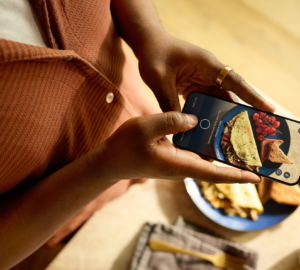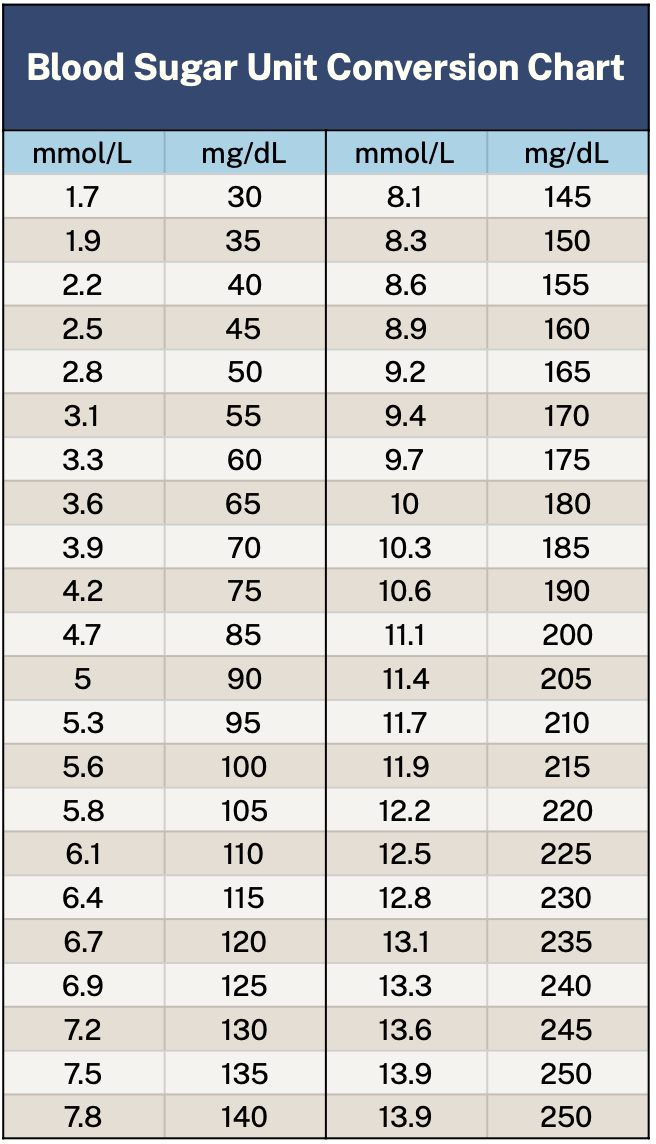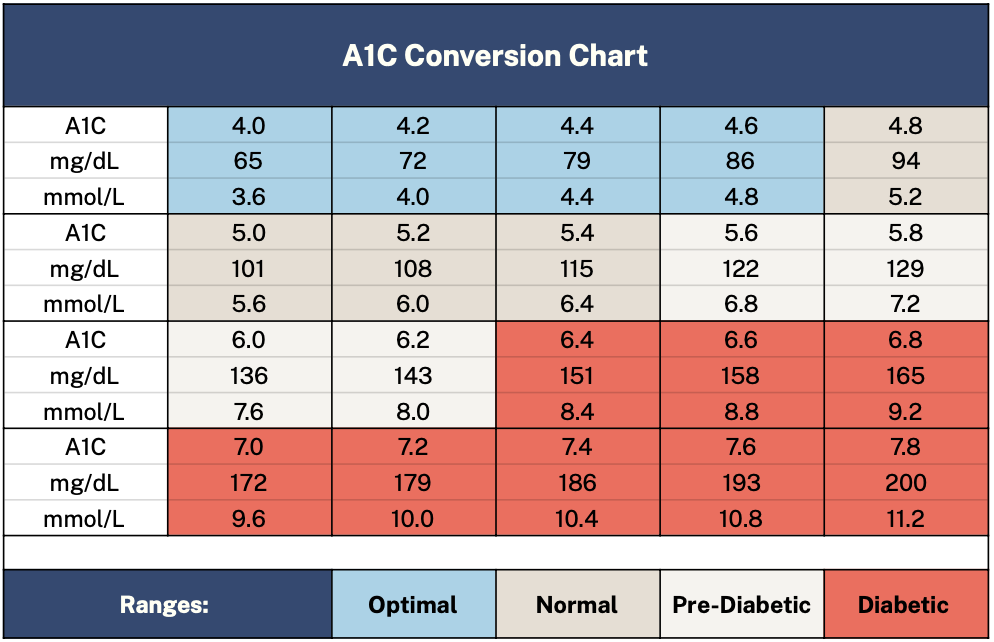Monitoring your blood sugar levels is important, but knowing how to interpret them is what truly supports long-term wellbeing. Understanding how to track and analyze your blood sugar can help you recognize the impact of fluctuations on your health.
What Is a Blood Sugar Conversion Chart?
A blood sugar conversion chart allows people to accurately interpret their blood sugar levels regardless of the unit of measurement used, which can vary based on the test you choose. (See “4 Methods of Measuring Blood Glucose Levels” below.)
There are different types of charts available to help people convert their blood glucose levels from one unit of measurement to another. Here are two common types of blood sugar conversion charts.
1. Convert between mg/dL and mmol/L
This chart allows you to convert your blood sugar levels between mg/dL and mmol/L.
Blood sugar levels are typically measured in milligrams per deciliter (mg/dL) in the United States, but in most other countries, they are measured in millimoles per liter (mmol/L). This chart is particularly useful for people who travel between countries or use devices with different units of measurement.
To convert between the two without a chart, it’s a simple formula: mg/dL = 18 × mmol/L. To get mmol/L from mg/dL, simply do the reverse and divide mg/dL by 18.
2. Convert blood glucose levels to A1C
This chart allows you to estimate your A1C based on your blood glucose levels, without having to get a blood test.
A1C is a blood test that measures the average blood glucose level over the past 2-3 months and is expressed as a percentage. This measurement provides an estimate of how well your blood glucose is being managed over time, without actually having to get a blood test. If you know your average blood glucose, the conversion chart gives you an estimation of your A1C based on this average.
You can also use our A1C calculator:
What Should Your Glucose Levels Be?
The normal range for blood glucose levels varies depending on your age, health status, and other factors. It is also important to note that blood glucose levels can vary depending on food intake, exercise, stress, and medication use.
Ideal fasting levels
Fasting blood glucose level refers to the amount of glucose in the blood after a period of not eating or drinking anything, typically 8 hours or more. A fasting blood glucose level between 70 and 100 mg/dL (3.9 and 5.5 mmol/L) is considered normal.
Morning fasting glucose (your blood sugar levels upon waking) is an indicator of insulin sensitivity and long-term health outcomes. Morning fasting blood glucose levels above 100 mg/dL (5.6 mmol/L) may indicate insulin resistance.
« Normal » glucose levels
Normal blood glucose level refers to your blood sugar level at any time of the day, whether before or after meals. Blood glucose levels before meals should generally be between 70 and 100 mg/dL (3.9 and 5.6 mmol/L) for healthy, non-diabetic adults. Blood glucose levels should generally be below 140 mg/dL (7.8 mmol/L) two hours after eating.
High glucose levels
A blood glucose level above 180 mg/dL (10.0 mmol/L) is considered high in people without diabetes. Consistently high blood glucose levels—i.e., when levels remain elevated after 8-10 hours of not eating or are greater than 140 mg/dL or 7.8 mmol/L two hours after a meal—are associated with insulin resistance. This can affect your mood, focus, and hunger levels, and possibly lead to longer-term complications like diabetes, insulin resistance, and cardiovascular disease.
What Are Glucose Spikes?
Have you ever felt a sudden burst of energy after eating, only to have it followed by a quick crash? If so, there’s a good chance you’ve experienced a glucose spike.
A spike is when your glucose levels rise sharply after eating, sometimes followed by a rapid drop. Spikes usually occur within one or two hours after you start eating and can last from a few minutes to several hours. The duration and intensity can differ from person to person, and even from meal to meal.
It’s perfectly normal for glucose levels to fluctuate throughout the day. However, when they spike above your optimal range, it’s a sign that you may want to pay attention and even possibly make some changes.
While diet is often the biggest reason for spikes, factors like meal timing, genetics, dehydration, and PCOS can all play a role as well. In general, glucose spikes are considered problematic when they are consistently high or occur frequently. High blood sugar levels, also known as hyperglycemia, can cause symptoms such as lethargy and fatigue.
On the other hand, some spikes aren’t a cause for concern. A blood sugar spike after a HIIT workout, for instance, is normal, since physical activity causes the body to release stored glucose to use for energy. However, if your glucose levels remain elevated 1-2 hours after the workout, it may indicate a challenge with blood glucose regulation.
In the morning, many individuals also experience a rise in glucose levels as the liver releases glucose to prepare the body for being active, also known as the dawn phenomenon. This type of surge in glucose is also normal.
READ MORE: 7 Possible Reasons Your Glucose Levels Are High
What Do Low Blood Glucose Levels Mean?
Low blood glucose levels, also known as hypoglycemia, occur when the amount of glucose in the blood falls below normal levels. While the specific threshold for hypoglycemia can vary depending on the individual, blood glucose levels below 70 mg/dL (3.9 mmol/L) are generally considered low.
Symptoms of low blood glucose levels include:
- Shaking or trembling
- Sweating
- Palpitations or rapid heartbeat
- Fatigue or weakness
- Confusion or difficulty concentrating
- Irritability or mood changes
- Blurred vision
- Headache
- Nausea or stomach discomfort
Low fasting glucose levels can be caused by a variety of factors, including not eating enough food, exercising too much without adequate calories, or drinking alcohol without consuming food. Rebound hypoglycemia can occur after consuming a large meal that is high in carbohydrates and/or fats.
Nocturnal hypoglycemia can occur during sleep and be caused by various factors such as too much insulin or delayed meals. In some cases, low fasting glucose levels can also be a sign of an underlying medical condition such as an adrenal or pituitary gland disorder. One example is polycystic ovarian syndrome (PCOS), which can lead to insulin resistance and cause hypoglycemia in some cases.
4 Methods of Measuring Glucose Levels
Glucose levels can be measured using several methods, including:
- A1C test: This test measures the average blood glucose levels over the past two to three months by assessing the amount of hemoglobin that is glycated (has glucose attached).
- Glucose tolerance test: This test involves drinking a glucose solution and having blood glucose levels checked at specific intervals over the course of several hours.
- Finger prick test: This test involves pricking the finger to obtain a small sample of blood, which is then placed on a test strip and inserted into a blood glucose meter. The meter provides a reading of the current blood glucose level (i.e. only at the moment the test was taken).
- Glucose Biosensor: This involves wearing a device, like the Stelo Glucose Biosensor, that continuously measures glucose levels throughout the day.
Although each of these has its reason for use, using a glucose biosensor has several advantages over other methods as it provides real-time information on blood glucose levels.
This allows you to detect trends in blood glucose levels over time, such as blood glucose spikes or fluctuations that occur during sleep, with stressors, or after meals. Additionally, it eliminates the need for frequent finger pricks or trips to a healthcare provider’s office for tests.






